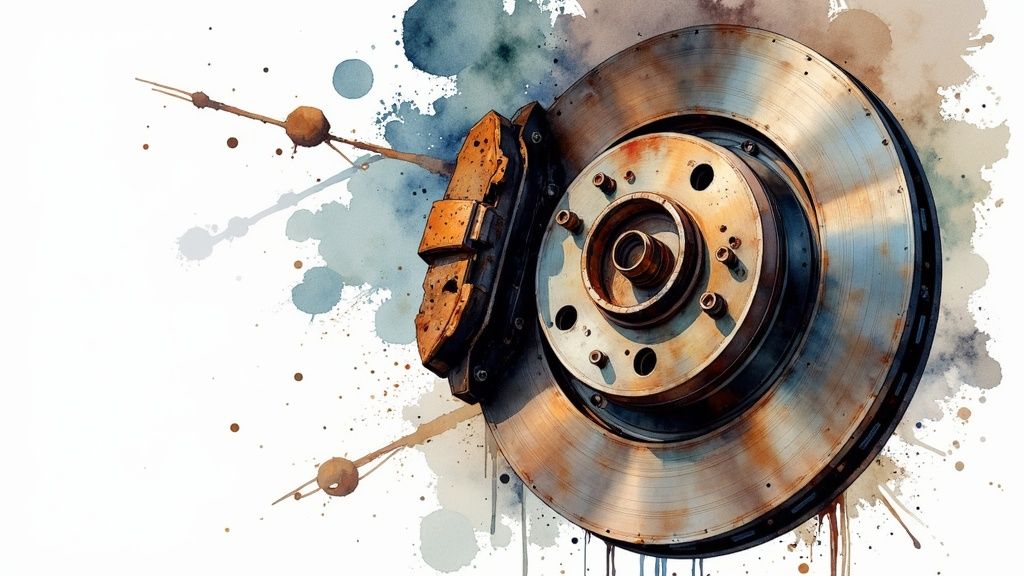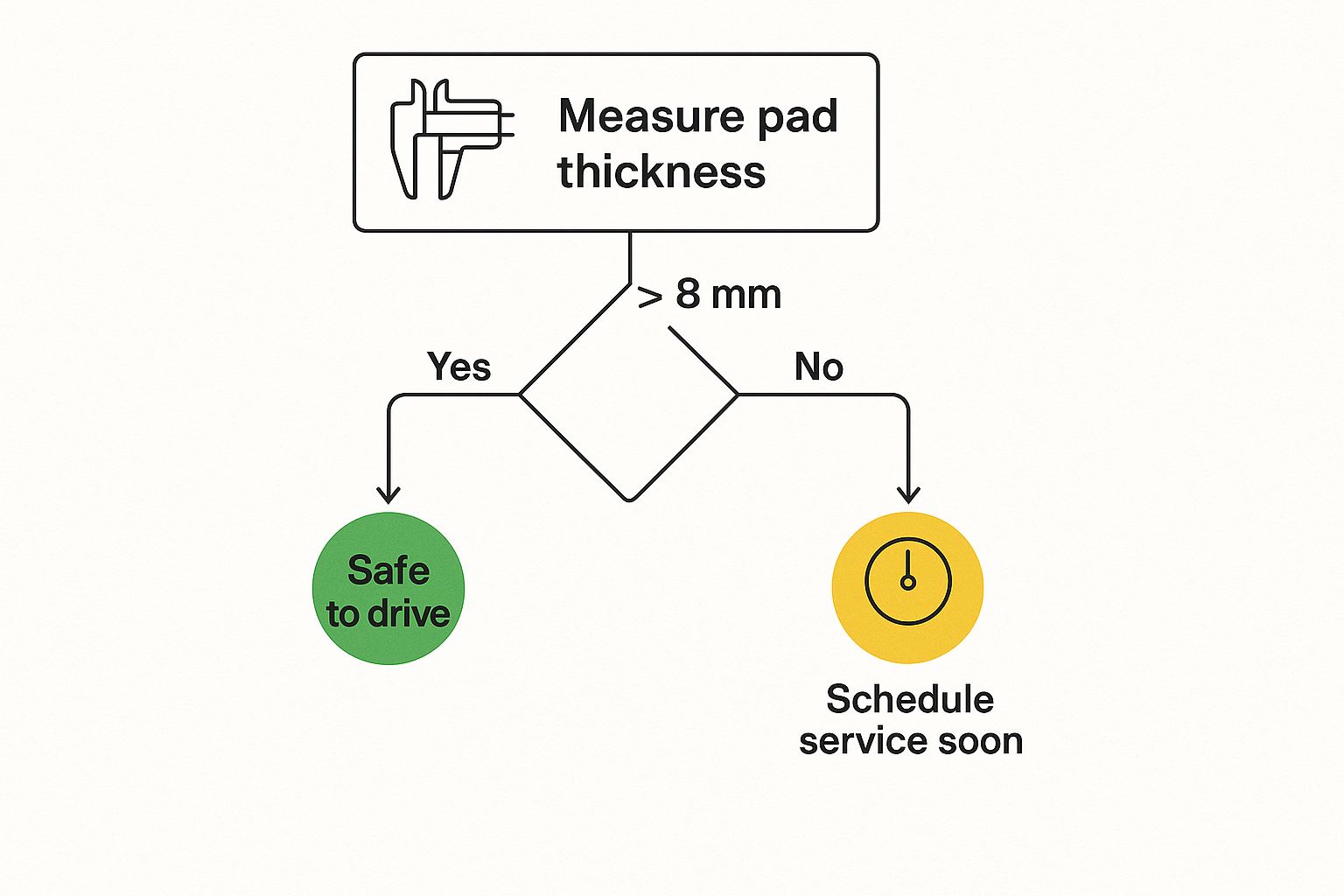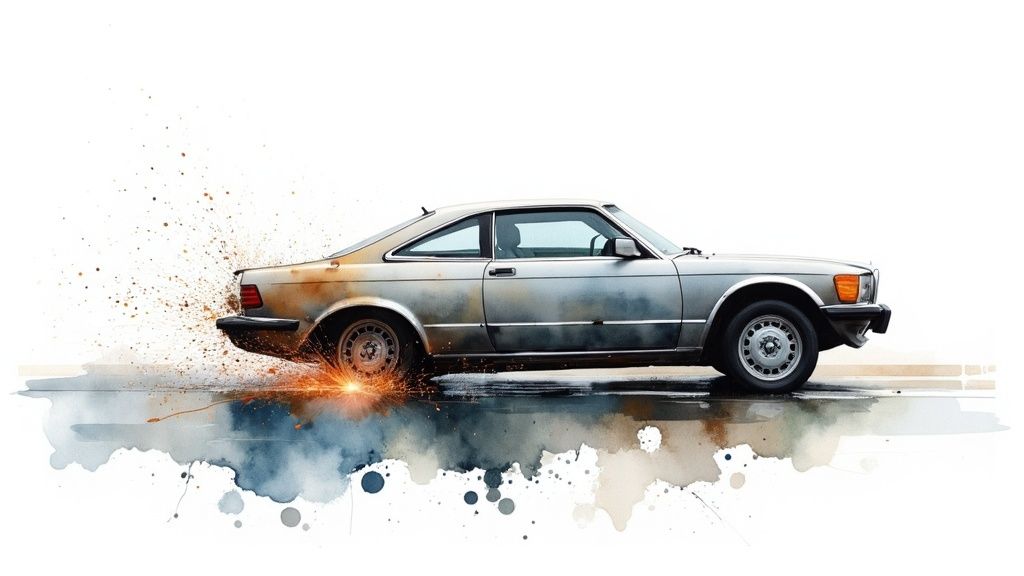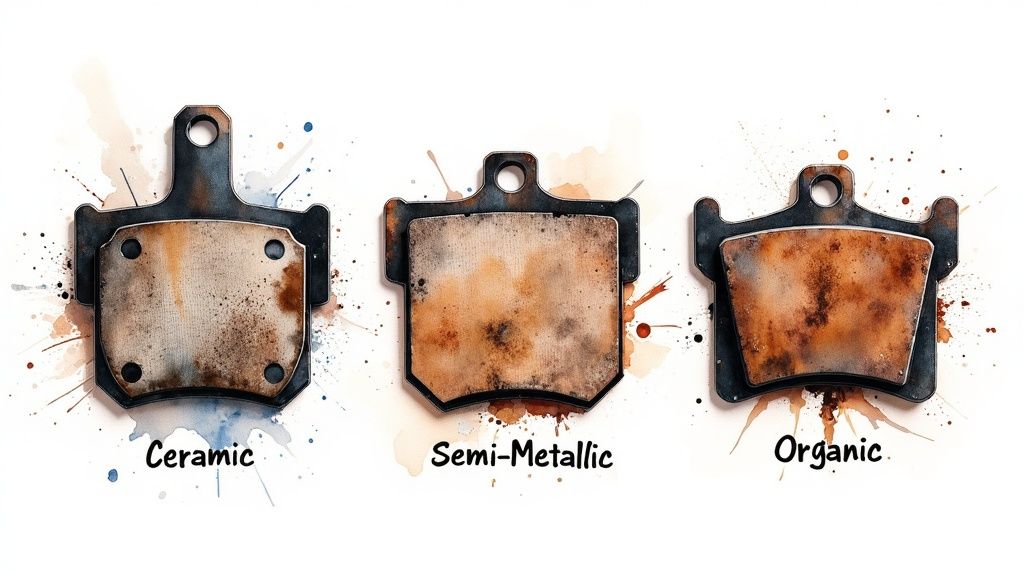
Kwik Kar Service Coupon
Get upto $20 OFF on all services.

Your vehicle's brake pads are crucial for safe driving. They transform kinetic energy into friction, allowing your car to slow down and stop. Because these components experience constant wear and tear, they eventually need replacing. This brings us to a vital question: when is the right time to replace brake pads? Understanding this timing isn't just about routine maintenance; it's about safeguarding your investment and, most importantly, your safety.
Brake pads work together with brake rotors (or discs) to generate the friction needed for stopping. When you press the brake pedal, hydraulic pressure activates the brake calipers, squeezing the pads against the rotors. This friction converts the vehicle's momentum into heat, effectively slowing the car. Because of this constant contact and friction, brake pads wear down over time.
Replacing your brake pads at the right time is crucial for several reasons. Worn-out brake pads significantly reduce your stopping power, increasing the risk of accidents. Delaying replacement can also lead to more extensive and expensive damage to other brake system components, such as the rotors and calipers.
For example, worn pads can score the rotors, necessitating resurfacing or replacement. Addressing brake pad wear early prevents a minor repair from becoming a major expense. The global automotive brake pad market, currently valued around USD 4 billion, is projected to grow significantly. This growth highlights the importance of this often-overlooked component and underscores the increasing global demand for vehicles – and dependable braking systems. For more detailed market statistics, you can Explore the Automotive Brake Pad Market.
Several factors influence brake pad lifespan. Driving habits, such as frequent hard braking or city driving, contribute to faster wear. Driving conditions, like mountainous terrain or heavy traffic, also play a role. The brake pad material—ceramic, semi-metallic, or organic—also affects longevity and performance. Understanding these factors helps you anticipate when your brake pads might need attention. Ultimately, recognizing the signs of worn brake pads and addressing them promptly ensures optimal vehicle safety and performance.
Your vehicle often communicates when its brake pads are wearing down. Knowing how to interpret these signals is vital for your safety and can prevent more expensive repairs later. Let's explore these warning signs, from subtle hints to urgent alerts.
One of the most common early signs of worn brake pads is a high-pitched squealing or screeching when you brake. This isn't accidental. Many brake pads have wear indicators, small metal tabs that contact the rotor and make this noise when the pad material gets thin. While other issues like dust or debris can sometimes cause squealing, persistent squealing shouldn't be ignored.
A grinding noise is a serious warning. This means metal-on-metal contact: your brake pad material is gone, and the metal backing plate is grinding against the rotor. Driving in this condition damages the rotors, potentially requiring costly replacements. This also significantly reduces your stopping power, creating a dangerous situation.
A pulsing or vibrating brake pedal when braking could signal warped rotors, often caused by excessive heat from worn-out brake pads. Uneven pad wear can also contribute to this vibration.
If you need to press the brake pedal further or your vehicle takes longer to stop, your brake pads are likely thinning and losing effectiveness. This reduced stopping power increases your risk in sudden stops or emergencies.
You can often visually check your brake pads without tools. Look through the wheel spokes. If you see less than 1/4 inch of brake pad material, it's time for a replacement. The infographic below offers a visual guide:

This infographic simplifies things. Over 8mm, you're good. Between 3mm and 8mm? Schedule service soon. Under 3mm? Immediate replacement is necessary.
Modern vehicles often have a dashboard warning light for brake system issues. This could indicate various problems, including low brake fluid, but it can also mean worn brake pads, especially with other warning signs.
If your car pulls to one side when braking, a stuck brake caliper or uneven brake pad wear on one side could be the culprit. This uneven braking force is dangerous and needs immediate attention. It increases stopping distance and makes it difficult to control the car during braking.
To help you understand the urgency of different brake pad warning signs, we've created a handy guide:
Brake Pad Warning Signs: Your Urgency Guide
A comprehensive guide to different brake pad warning signs, their severity levels, and recommended response timeframes
| Warning Sign | Severity Level | Cause | Recommended Action | Timeframe for Replacement |
|---|---|---|---|---|
| Squealing/Screeching | Moderate | Wear indicators | Inspection | Soon |
| Grinding | Severe | Metal-on-metal contact | Immediate inspection and repair | Immediately |
| Pedal Vibration | Moderate to Severe | Warped rotors, uneven wear | Inspection | Dependent on diagnosis |
| Increased Stopping Distance | Moderate to Severe | Thin brake pads | Inspection | Soon |
| Less than 1/4 inch pad thickness (visual) | Severe | Worn brake pads | Replacement | Immediately |
| Dashboard Warning Light | Varies | Multiple potential causes including worn pads | Inspection | Dependent on diagnosis |
| Pulling to One Side | Severe | Stuck caliper, uneven wear | Immediate inspection and repair | Dependent on diagnosis |
This table summarizes the key warning signs and their corresponding severity levels. Remember, any unusual brake behavior warrants professional inspection.
Recognizing these seven signs empowers you to address brake pad issues promptly. Whether it’s a slight vibration or a loud grinding, understanding these signals helps maintain your vehicle’s safety and performance. Contact Kwik Kar Richardson in Richardson, TX for expert brake inspections and service. Our ASE-certified technicians will provide reliable service and help keep your vehicle safe. Schedule your appointment today.

While estimated brake pad lifespan often falls between 30,000 and 70,000 miles, this range can be misleading. Many factors influence the actual lifespan, making personalized assessments essential. Let's explore these factors so you can better anticipate your brake pad replacement needs and prevent safety hazards.
Driving style significantly affects brake pad wear. Frequent hard braking, typical in stop-and-go city driving, generates more friction and heat, accelerating wear. If most of your driving is in a busy urban setting, expect your brake pads to wear out faster than someone primarily driving on the highway.
For example, city drivers with short, stop-and-go commutes may need replacements every 20,000 miles, while highway drivers could reach 50,000 miles or more. Understanding these variations is key. For a more detailed explanation, check out this helpful article: How Often Should I Replace My Brake Pads?.
Vehicle weight and terrain also affect brake pad lifespan. Heavier vehicles demand more braking force, increasing stress on the pads. Similarly, driving in mountainous or hilly areas requires more frequent and forceful braking than on flat roads, accelerating wear. Imagine carrying a heavy backpack—stopping requires more effort, just like your brakes with a heavier load or on steep inclines.
Brake pad quality, like tire quality, affects lifespan and performance. Premium brake pads, often made from ceramic, tend to last longer, produce less dust, and offer smoother braking. Economy pads, generally semi-metallic or organic, wear out faster and may generate more noise and dust. While premium pads cost more upfront, their longevity and performance can make them a wise investment.
To help illustrate the differences, let's look at a comparison table:
Brake Pad Performance Matrix: Lifespan by Type & Use
| Brake Pad Type | Urban Driving (miles) | Highway Driving (miles) | Cost Range | Best For |
|---|---|---|---|---|
| Organic | 20,000-35,000 | 35,000-50,000 | Low | Everyday driving, lighter vehicles |
| Semi-Metallic | 30,000-50,000 | 50,000-70,000 | Moderate | Heavier vehicles, towing, performance driving |
| Ceramic | 50,000-80,000 | 70,000-100,000 | High | Long lifespan, quiet operation, low dust |
As you can see, the type of brake pad you choose can significantly impact its lifespan and overall performance based on your driving conditions. Choosing the right pad for your needs will ensure optimal braking and value.
Modern vehicles, especially electric and hybrid models, increasingly use regenerative braking systems. These systems capture braking energy and convert it to electricity, reducing strain on traditional friction brakes and extending pad life. Furthermore, advances in brake pad materials continue to improve performance and longevity.
The global brake pad market, valued at about USD 3.07 billion in 2023, is projected to reach USD 5.93 billion by 2031, showcasing continuous innovation. This growth is driven by increased safety awareness and a growing global vehicle fleet. Learn more about the brake pad market. These advancements are important factors when considering brake pad replacement.
Taking control of your brake pad inspections can save you money. However, knowing your limitations is essential. This section helps you make informed decisions about brake pad replacement, whether through DIY checks or professional service.
Several methods help you assess brake pad wear without specialized equipment. You can often visually inspect your brake pads by shining a flashlight through the wheel spokes. Look for a thin edge indicating wear. If you see less than 1/4 inch of brake pad material, it's time for a replacement.
Some simple tools can also be helpful. A small mirror and a flashlight can help you see the inner brake pad, which often wears faster. Specialized tools are also available to measure brake pad thickness without removing the wheel.
These DIY methods give valuable insights into your brake pad condition, especially if you are comfortable working on your car.
While DIY inspections are helpful, professional inspections provide a more complete evaluation. Mechanics have the expertise and tools to check your entire brake system, not just the pads.
During a professional inspection, the mechanic will usually:
This detailed assessment gives you a complete understanding of your brake system’s condition.
The best approach depends on your comfort level, skills, and budget. If you are mechanically inclined, a DIY check can be a good first step. However, even with regular DIY checks, periodic professional inspections are still recommended. Professional inspections are especially crucial if you notice any issues like squealing, grinding, or vibration.
Here is a table to help you decide:
| Factor | DIY Inspection | Professional Inspection |
|---|---|---|
| Cost | Low | Moderate |
| Time | Short | Moderate |
| Skill Level | Basic | Professional |
| Thoroughness | Basic | Comprehensive |
By understanding DIY and professional inspection methods, you can create a balanced approach to brake pad maintenance. This proactive strategy ensures your vehicle’s safety and helps you make informed decisions about brake pad replacement. Remember, Kwik Kar Oil Change and Auto Care in Richardson, TX offers expert brake service for thorough inspections and replacements as needed.
Whether you're a DIYer or prefer a professional touch, understanding the brake pad replacement process is key. It helps you make informed choices and ensures your vehicle's safety.
Replacing your own brake pads can be a rewarding experience for those mechanically inclined. However, it's essential to prioritize safety and precision.
Gather Your Tools: You'll need a jack, jack stands, a lug wrench, a socket set, a C-clamp, brake cleaner, and of course, your new brake pads. Investing in quality tools, especially for repeated use, is a smart move.
Safety First: Before starting any work, secure your vehicle with jack stands. Never rely solely on a jack. Adding wheel chocks provides an extra layer of safety.
The Process: Generally, the process involves removing the wheel, compressing the brake caliper piston, removing the old pads, installing the new ones, and reassembling everything. Specific steps may vary depending on your car's make and model. A repair manual specific to your vehicle can be an invaluable resource.
This careful approach ensures a successful DIY brake pad replacement.
If DIY isn't your thing, professional auto repair is a great option. A qualified mechanic will thoroughly inspect your brake system, ensuring the job is done right and catching any potential problems.
Initial Evaluation: The mechanic will begin with a visual inspection of the entire brake system, including pads, rotors, calipers, and brake lines.
Component Inspection: They'll also examine related components, such as rotors, which may need resurfacing, or calipers exhibiting wear and tear.
The Replacement: Professional replacement includes removing the old pads, lubricating contact points, installing the new pads, and thoroughly testing the brake system.
This professional check-up provides a comprehensive overview of your brake system’s health. For those in the Fort Worth area, resources like this guide to auto repair services can help you find reputable shops.
The time required for a brake pad replacement depends on the vehicle. For most cars, it typically takes one to two hours. Larger vehicles or those with complex systems may take longer. Costs depend on the type of brake pads (ceramic, semi-metallic, or organic) and labor rates, usually ranging from $150 to $300 per axle.
Knowing these estimates helps you set realistic expectations and assess quotes. Understanding brake pad replacement empowers you to prioritize safety and manage your budget effectively.

Your driving style significantly impacts the lifespan of your brake pads and your overall car maintenance expenses. Smart driving techniques can dramatically increase the life of your brake pads, potentially saving you money on replacements down the line.
Maintaining a safe following distance is paramount for extending brake pad life. Sufficient space provides ample reaction time, allowing for smooth, gradual braking instead of abrupt stops. This minimizes the friction and heat that contribute to brake pad wear.
The three-second rule is a helpful guideline. Pick a stationary object, and when the car in front passes it, begin counting. You should reach the same object no less than three seconds later. This buffer promotes safer and gentler deceleration.
Looking ahead and anticipating traffic patterns is key to preserving your brake pads. By anticipating slowdowns, you can coast and gradually reduce speed, minimizing hard braking.
This proactive approach not only reduces wear and tear on your brake pads but also improves fuel efficiency. Avoid tailgating, which often necessitates sudden braking and contributes to premature pad wear.
Engine braking is particularly useful on long downhill stretches. It utilizes the engine's resistance to slow the vehicle, reducing reliance on the brakes. This is especially beneficial in preserving brake pads and preventing overheating on steep inclines.
Use this technique judiciously, considering other drivers. Downshifting to a lower gear enhances engine braking effectiveness, distributing the braking effort and lessening strain on your brake pads.
Your vehicle's weight directly impacts braking demands. Heavier loads require more force to stop, increasing brake pad wear. Be mindful of how much weight you regularly carry, as it can shorten the life of your brake pads.
Proper tire maintenance also plays a vital role. Underinflated tires increase rolling resistance, requiring more braking effort and accelerating pad wear. Regular tire pressure checks are essential for optimal brake performance and longevity.
Certain driving habits can unknowingly accelerate brake pad wear. "Riding the brakes," even lightly, creates constant friction and heat. Resting your foot on the brake pedal, even slightly, can also cause premature wear.
By avoiding these habits and implementing the strategies mentioned, you can significantly extend your brake pads' lifespan, saving money and enhancing safety. For expert advice and brake inspections in Richardson, TX, contact Kwik Kar Oil Change and Auto Care. Their certified technicians provide reliable brake service to keep you safe on the road.
Maintaining your vehicle's brakes requires a careful balance between safety and cost. This section summarizes key takeaways, highlighting how recognizing early warning signs can prevent accidents and save money in the long run.
Delaying brake pad replacement can trigger a series of expensive problems. Worn brake pads can damage your rotors, necessitating resurfacing or even complete replacement, significantly increasing repair costs. Furthermore, ignoring worn pads can strain your calipers, potentially leading to caliper failure – a much more expensive repair.
Think of it like a small roof leak. Ignoring it can lead to major water damage and costly repairs. Similarly, neglecting worn brake pads can transform a minor repair into a significant financial burden. Addressing the issue early is always the most cost-effective solution.
Several factors influence the decision of when to replace your brake pads. Your driving habits, vehicle type, and the type of brake pads all affect their lifespan.
Considering these factors, along with regular inspections, helps determine the optimal replacement time.
A personalized maintenance strategy is crucial for balancing safety and budget. This strategy includes:
By being proactive and informed, you ensure optimal brake performance and avoid expensive repairs. A small investment in timely brake pad replacement offers significant returns in vehicle longevity, performance, and peace of mind.
Ultimately, replacing your brake pads is about protecting your investment in your vehicle and your safety. Ignoring warning signs compromises your ability to stop effectively, increasing accident risk. The peace of mind that comes with knowing your brakes are in top condition is priceless. Timely brake pad replacement ensures confident and secure driving, leading to a safer and more enjoyable driving experience.
For professional brake service and maintenance in Richardson, TX, visit Kwik Kar Oil Change and Auto Care. Their ASE-certified technicians provide reliable and thorough brake inspections and replacements to keep you safe on the road. Schedule your appointment today.
CLICK LINK BELOW TO LEARN MORE ABOUT OUR SERVICES

Get upto $20 OFF on all services.

Get upto $20 OFF on all services.